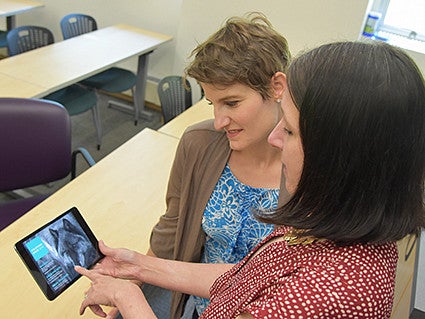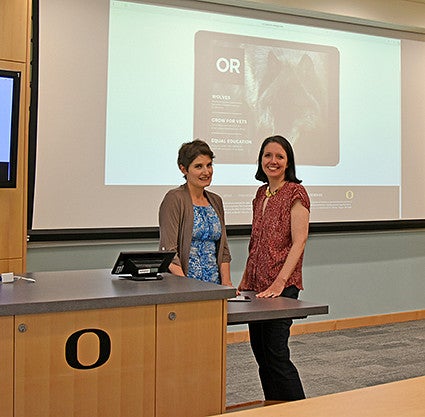Story by Andra Brichacek, video and photos by Emma Oravecz
Before UO School of Journalism and Communication (SOJC) instructor Kathryn Thier was a journalism teacher, she was a reporter. In 2004, she worked on a major series for The Charlotte Observer about a police chase, instigated by a white police officer, that resulted in the death of seven African-American teenagers. The series earned first-place awards from the Society of Professional Journalists and the North Carolina Press Association.
It also made Thier question her role as a journalist.
“The more we reported the story, the more it brought up emotions in the community and letters to the editor,” she said. “I started to wonder: What effect are we having?”
Part of the series was the story of an African-American barber who wrote, directed and produced a play about the tragic incident that was meant to heal the rifts in the community.
“After that story, the letters to the editor changed,” Thier said. “Now people were saying, ‘Thank you for showing us the good,’ ‘Thank you for showing us what’s possible,’ and ‘Thank you for portraying my community fairly and accurately.’”
She couldn’t help but notice the sharp contrast between the effects of the articles focused only on the problems — journalism’s traditional subject matter — and her story, which centered on a solution.
“The whole experience really broke open something inside of me about how we cover communities,” she said. “Journalists need to ask hard questions and can’t shy away from the truth. But at the same time, we must ask what damage we are creating.”
The whole story

More than a decade after that watershed moment, Thier has become one of the first journalism educators in the nation to teach a university course in solutions journalism. In the spring, she also collaborated with SOJC Assistant Professor Nicole Dahmen, faculty adviser for the student-produced OR Magazine, to help student journalists produce multimedia stories for the iPad publication’s “Solutions Issue.”
The term “solutions journalism” — popularized by David Bornstein and Tina Rosenberg, co-founders of the Solutions Journalism Network (SJN) and The New York Times “Fixes” column — refers to an approach to reporting the news that addresses not just the problems, but also the ways people are working to solve them. Bornstein and Rosenberg founded the SJN with Courtney Martin in 2012 because research was confirming what they had seen anecdotally: Rather than inciting positive action, today’s around-the-clock “if it bleeds it leads” news coverage is causing depression, anxiety and compassion fatigue among news audiences. Solutions journalism, in contrast, has been shown to make readers feel more engaged, informed and optimistic.
“Journalists see themselves as the guardians of democracy,” said Thier. “But if people become so depressed by what we’re writing that they feel they can’t act or contribute to social progress, are we doing what we set out to do? It turns out people need examples of what does work in order to be able to think about what can work.”
Despite its focus on the positive, when done right, solutions journalism is neither “fluff” or “advocacy” journalism. “Solutions journalists bring the same journalistic rigor and skepticism to reporting on responses to social problems as they do to reporting on the problems themselves,” Thier said. “Journalists make choices all the time about what stories to tell and what people to quote. Flipping the frame of the story to a solution is just another choice. And that choice helps provide readers with a fuller picture of our world. It’s telling the whole story.”
Innovation in the SOJC
Thier brought the idea of teaching a course in solutions journalism to Mark Blaine, the SOJC’s journalism area director, in early 2015. “I knew Mark would be open to it because he’s innovative and progressive,” she said. “He suggested I apply for funding from the SOJC’s Agora Journalism Center. They really liked my proposal and gave me a grant to develop the course.”
At the same time, Dahmen was working on related research on contextual journalism and restorative narrative. “I’ve always been interested in the long-term effects of breaking-news coverage on individuals and communities,” Dahmen said. “What I really appreciate about solutions journalism is that it allows us to give a more complete perspective and bigger picture regarding responses to problems, whether it’s economic disparity, racial tensions or natural disaster.”
Dahmen, who had interviewed SJN’s Bornstein for her research, connected him with Thier last November. Her timing couldn’t have been better — the organization was about to host its first-ever brainstorming and training session for journalism educators. The SOJC sent Thier to New York City, where she met with J-school instructors from Temple University, Texas State, Arizona State and Kent State.
Thier quickly developed a course for winter term that would provide a deep dive into solutions journalism, covering such basics as the “four qualities” of a true solutions story and the “seven impostors” to avoid. “My course answers the basic questions, such as: What is it, and what isn’t it?” she said. “How do you find the stories and report them? How do you source them? And what’s the deeper meaning of solutions journalism?”
Meanwhile, Dahmen was looking for a way to bring her research to the classroom, and solutions journalism seemed like an ideal focus for the upcoming spring issue of OR Magazine. “The course and resulting publication are cutting edge,” she said. “And taking a solutions reporting approach to the sixth issue seemed like a good direction to continue its culture of innovation.”
It turned out to be the perfect laboratory for students to practice the solutions journalism theory they would learn in Thier’s course. Thier helped Dahmen coach OR Magazine’s student staff in the production of five multimedia features exploring solutions that are working in Oregon, including stories on ranchers’ efforts to coexist with wolves, cannabis as an alternative treatment for veterans with post-traumatic stress disorder, comprehensive sex education as a tool to combat teen pregnancy and Oregon schools’ successes with LGBTQ inclusion.
“I’m incredibly proud of the work these students did in crafting journalism that matters,” Dahmen said. “The stories are well-researched and reported, and they include beautiful and compelling photos, videos and infographics, with design and interactivity bringing the stories together.”
The SJN was impressed by the students’ work as well. “That magazine is fantastic,” said Rosenberg. “It’s the best example of college solutions journalism we have seen so far.”
The SJN has included the five OR Magazine stories in its Story Tracker, and the network recently published interviews with OR Magazine’s editor-in-chief Sami Edge, reporters Erin Hampton and Zachary Silva, as well as Thier and Dahmen. Thier’s syllabus and lesson plans are also featured on the organization’s website as a model for other journalism educators.

Journalism for the next generation
Hampton, a journalism major with a nonprofit administration minor who will graduate in 2017, took both Thier and Dahmen’s courses. Her OR Magazine story, “Against the Grain,” explores how an Oregon State University-based network is working to narrow the gender gap in the state’s farming industry — a problem that’s rampant throughout the nation.
While researching the piece, Hampton discovered that reporting from a solutions angle is not as easy as she thought it would be. “I struggled with it,” she said. “I had to keep reminding myself not to focus too much on a specific person, because the solution is in the infrastructure. And I had to keep asking: How do I give more examples and data to prove the solution is working?”
That thought process is exactly what Thier wants her students to experience. “Many of the students found that by learning about solutions journalism, they understand journalism in general better,” she said. “By deconstructing it so intensely and analyzing it so thoroughly, they realize what good journalism is really about.”
Hampton’s experience has solidified her focus on solutions journalism. Thier is helping her develop an independent study course for her senior year, and she’s working with Dahmen on her Honors College thesis on the intersection of solutions journalism with nonprofit organizations.
“I had honestly found myself discouraged with the traditional ‘watchdog’ approach to journalism, because it seemed the only thing I was learning was how to uncover negative aspects of our society,” she said. “I have always been an optimistic person, so I naturally gravitate toward stories that allow people to see the productive elements of their community.”
Hampton’s response to solutions journalism doesn’t surprise the SJN’s Rosenberg. “The most receptive to this are young people,” she said. “They don’t have to unlearn standard ways of doing business [like longtime journalists would]. And this generation is very interested in doing things that contribute to society.”
Thier — who recently had a research article on the effects of teaching and learning solutions journalism accepted for publication in Journalism & Mass Communication Educator — has found that this journalistic approach also bolsters the critical thinking skills SOJC graduates will need to navigate an industry where rapid change is the new normal.
“Nicole and I are trying to get our students to really think about their role as future professionals in this field,” she said. “Nobody knows where journalism is going to go. But by arming students with skills in an emerging practice as well as the ability to question and think critically about their future roles, we are setting them up to be journalists for many years to come.”
